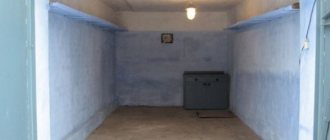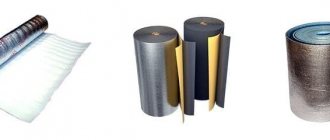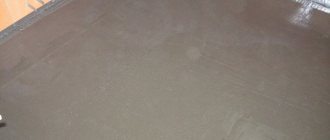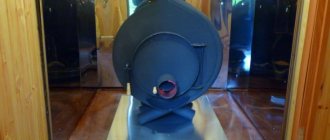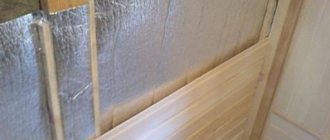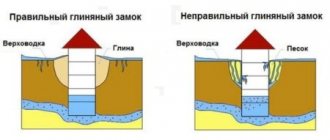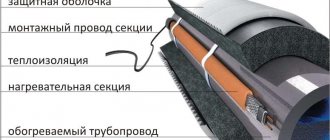Preparing the well for winter
So, now let’s look at the question - how to insulate a well made of concrete rings, and get acquainted with a number of preparatory measures:
We insulate the upper ring of the well using various methods, starting from a simple plastic cover and ending with a decorative log house in the form of a beautiful house above the well;
Decorative log house
We install special insulating structures inside the well itself - this can be an insulating cover made of combined heat-insulating materials, or “eternal” heating in the form of a concrete cover with an additional plastic hatch;
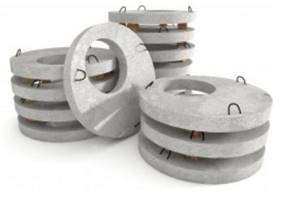
Concrete cover with hatch
We completely drain the water supply system in early autumn (if the residence is seasonal). This will protect the system from the appearance of ice jams, and thereby from expensive repair and restoration work.
If you belong to the type of people who do not like to spend extra money on luxury and sophistication, then the well can be insulated with a tight lid made in the form of a sandwich - its “filling” includes:
- The top layer is wood;
- The middle layer is insulation (PPU, expanded polystyrene or similar filler with environmentally friendly components);
- The bottom layer is powerful moisture-resistant plywood, which is not afraid of fumes, condensation, etc.

No less interesting, convenient and effective solution
If you decide to insulate a well for the winter without saving money, then all experts will unanimously advise you to install a reinforced concrete cover with a plastic hatch. This attribute will not even need to be removed for the summer - the service life of the cover is equal to the service life of the well, so you should not have any problems with its operation and repair.
We insulate the well ourselves using polystyrene foam
If you don’t have the slightest desire to turn to specialists, then you can do the insulation of a water supply well yourself. To do this, you just need to stock up on polystyrene (a special type of foam), which is sold not only in the form of slabs, but also in a semicircular shape. Also, it is worth noting that the range of the Russian market is represented by products of different diameters and thicknesses.
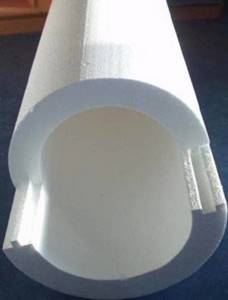
The so-called “shell” made of polystyrene foam
Before you start insulating a well with foam plastic, you need to dig a trench 1.5 meters deep around the perimeter of the well. Then, we select the “shell” to match the diameter of the rings and install it around the source. After installing the heat insulator, the trench is buried (also find out how to insulate an attic in a private house).
Now, as mentioned above, you can make a special lid and close the well.
Insulation with polyurethane foam
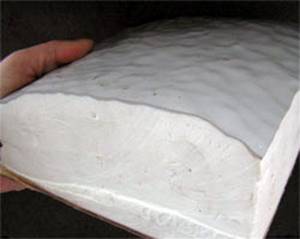
Polyurethane foam in final form
You've probably heard about this miracle material, which has been tested not only by the Russian cold - polyurethane foam structures are successfully used in Antarctica and even in space! It does not rot, does not absorb water into its structure, does not emit harmful substances, and most importantly, mice do not live in it.
In order to insulate a well using this material, it is necessary to dig a trench around it to the depth of freezing of the soil.
So, after the optimal temperature has been established outside, you can begin thermal insulation. To do this, you will need polyurethane foam cylinders and a gun to apply it to the walls of the well.
The photo shows an example of applying polyurethane to a roof.
The layer should be made uniform, and do not forget about protecting it from sunlight (to do this, just quickly apply foam to the surface and bury the trench).
How to insulate a well?
It is recommended to use the following as thermal insulation material:
- penofol . Foil-coated thermal insulation material, the installation of which allows you to avoid water freezing. But because penofol is a soft material that does not withstand mechanical loads well and has insignificant thickness, so insulating a well with penofol is extremely rare;
- polystyrene foam or polystyrene foam . Insulating a well with polystyrene foam (penoplex) or polystyrene foam is the most common method, which is optimal for doing the work yourself. Rigid insulation materials are good because they do not allow moisture to pass through, have high thermal insulation rates, have a long service life, are inexpensive and easy to install. The only drawback is the stability of the geometry. To insulate a concrete well with polystyrene foam, you need to cut the sheets into even strips and fix them on the concrete so as to minimize the area of uninsulated space. It is recommended to blow out the joints of the strips with foam;
- polyurethane foam . An ideal, but expensive solution for insulating a well made of concrete rings. The advantages are obvious and are as follows: absolute tightness, not subject to deformation, resistance to rotting, does not require preliminary preparation, makes it possible to insulate surfaces of different configurations (couplings, pipe insertion points, etc.). In addition to the price, users are deterred by the need to attract craftsmen with equipment for spraying polyurethane foam, and this increases the cost of work;
- shell for insulation of wells . An affordable analogue of sprayed polyurethane foam. The PPU shell consists of two halves, which are easily installed on the concrete rings of the well. A variety of pipe configurations and diameters allows for complete sealing. The joints of two shells are blown with foam. Thus, the tightness of the insulation is achieved.
Note. If you want to use only natural materials, you can use straw, sawdust, flax tow, expanded clay.
Method two. We thermally insulate the upper ring of the structure
Every specialist will tell you that in order to prevent freezing of a well, you need to reduce the thermal conductivity of its upper ring. This method of thermal insulation is performed in two ways:
- by means of polystyrene foam;
- using polyurethane foam.
Let's look at the first method first.
We use polystyrene foam for the ring “under a fur coat”
Here you should prepare the following consumables for work:
- polyurethane foam;
- paint;
- plaster;
- insulating blocks made of polystyrene foam, which are connected using a tongue-and-groove system.
On a note! According to this technology, the first ring on top will be completely insulated, while the second only partially. Now to work!
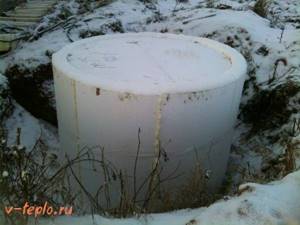
Step one. Work should begin with preparatory activities. Dig a pit 20 centimeters wide and approximately 0.5 meters deep around the ring. Then thoroughly clean the surfaces from dirt and install the first “fur coat” ball. At this time, make sure that the density of all connections is maximum! Blow out the joints with foam to seal them. Having finished with the first level, proceed to assembling the second and gluing it to the ring. Blow out the gaps that have formed between the layers with foam.
Step two. Next, begin plastering the surface of the rings. This will protect the foam from the negative effects of the sun's rays, which, as we know, worsen the thermal insulation properties of this material. After the plaster has completely dried, apply paint to it - this will prevent the finish from getting wet.
Step three. All that remains is to fill the pit and thoroughly compact the earth.
Penoplex, we insulate the foundation reliably and correctly
We recommend that you read our article on insulating the foundation yourself. You can find out more here
We use polyurethane foam for the ring “under a fur coat”
If you chose polyurethane foam as insulation, then follow these steps. First, dig a similar pit (as in the previous method of insulating a well for the winter), and then build a wooden frame around the first ring. But this is in general terms; let’s analyze the procedure in more detail. Prepare the following materials for work:
- paint;
- dowels;
- polyurethane foam sprayer;
- collapsible metal formwork;
- plaster;
- a piece of plastic film;
- wooden bars.
Step one. Traditionally, start by digging a pit, but narrower (maximum 10 centimeters). After this, install bars around the first ring in increments of approximately 40 centimeters. Cover the edges of the trench with formwork made of thin sheet steel, which will exactly follow all the contours. Cover the formwork with the prepared film. For what? This is explained by the fact that the adhesion of foam plastic is very significant, and therefore dismantling the formwork is impossible.
Step two. Having finished building the formwork, you will notice that a void has formed between it and the ring - this is what needs to be filled with insulation. Upon completion of pouring, the polyurethane foam will increase in volume, and the trench will therefore be filled as densely as possible.
After this, you need to wait until the material is completely dry. As soon as this happens, dismantle the formwork. Plaster the finished surface and apply a layer of paint to it. Fill the void left after formwork with earth and compact it thoroughly.
On a note! It is also advisable to cover the well with a lid, which was described in one of the previous paragraphs of the article.
Why does the well freeze?
Will the well freeze in winter? This can be predicted with a high degree of probability.
Firstly, if natural wood was used to construct the well, then it will not freeze even with prolonged exposure to sub-zero temperatures. Our ancestors took advantage of this property by constructing wells from wood.
Modern wells are built using reinforced concrete rings, and given that this material has high thermal conductivity, the well will freeze in the same way as the surrounding soil.
Secondly, you need to pay attention to the water level: if it does not exceed 1.1-2.2 m, then the risk of freezing is very high. If the well is deep and the water in it is below the freezing level of the soil, then the water does not freeze.
The third factor that must be taken into account is the depth of soil freezing in the region. In the southern regions, the freezing depth rarely exceeds 0.5 m, in temperate regions - 1-1.5 m, in the northern regions - below 1.5 m.
Thus, the question of how to properly insulate a well for the winter faces owners of reinforced concrete wells located in temperate and northern climates. For residents of the southern regions it is less relevant. There are enough minimal measures - the construction of an insulated cover, and the well itself does not need thermal insulation.

Freezing of a well made of reinforced concrete rings can be prevented by making high-quality insulation, allowing uninterrupted use of water from it all year round
Method one. Cover insulation
This technology is not complicated and consists of installing an additional cover inside the structure itself at ground level. We remind you that water from a well can be obtained in two ways - the old fashioned way, that is, using buckets, and using an electric pump. This article discusses exclusively the modern method.
You should start by preparing everything you need. Prepare for work:
- plywood sheet;
- glue;
- wire;
- a plastic pipe, which is necessary for ventilation;
- insulation, the thickness of which will be at least 5 centimeters (foam is ideal for this);
- polyurethane foam.
After this, proceed directly to the construction process.
Step one. Take a plywood sheet and cut out a couple of even circles with a diameter similar to the diameter of the structure itself. Make two holes in each circle - one for the hose and the other for ventilation.
On a note! Ventilation in this case is mandatory, since without it the water will soon begin to smell unpleasant, and its taste will noticeably deteriorate.
The diameter of the drilled holes is insignificant - no more than 6 centimeters, otherwise frosty air will be able to penetrate through the resulting cracks. It is more convenient to drill holes at one edge. Next, make 4 more holes for the wire around the perimeter of the second circle.
Step two. We continue to insulate the well for the winter. Cut a third circle of the same diameter, but this time from foam. Glue it to the bottom circle using high-quality wood glue, and fix the third circle on top. Once the glue has dried, place the ventilation pipe into the prepared hole. You can use polyurethane foam to seal joints.
Step three. The work is almost finished, all that remains is to make a special ring from the wire. To do this, take it and wrap it around the first ring, thereby fixing its circumference. After this, attach the wire to the ring, fixed in the four holes of the lower ring. Pass the hose into the required hole, and then lower the finished “sandwich” onto the ground line. The lid will be held in place with a wire, the well will be properly ventilated, but the water will not freeze.
The need for thermal insulation

This is by no means the main problem. The main thing is that the water does not freeze!
Where the well is planned to be used throughout the year, the structure is usually insulated during the construction stage. But country wells are sometimes made uninsulated. The result is not long in coming - already in the first fairly cold winter, serious problems begin.
It is necessary to protect a well from freezing for a number of reasons:
- The first, and most obvious, is the freezing of water and its transformation into ice. This process occurs quite slowly, because ice usually forms when the outside temperature reaches -15 ... -250C. However, even until this moment it will be inconvenient to use the source, since each time you will have to break through a thin ice crust with a bucket.
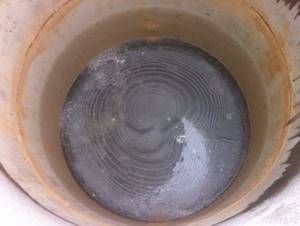
A layer of ice blocks access to water and leads to structural failure
- An ice plug that forms on the surface of the water can damage the walls of the well. This is due to the fact that when ice forms, its volume increases, and the edges of the plug begin to put pressure on the surrounding surfaces. If pressure is applied to the joint of reinforced concrete rings, then there is a possibility that they will separate, and if it is applied to a continuous area, then cracks may appear.
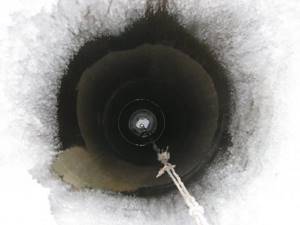
A small beginning of a big disaster
- The same problem is typical for wooden log houses. The difference is that in the case of a wooden structure, in almost 100% of cases, a layer of ice wedges between the crowns and pushes them apart. As a result, cracks form in the wall of the log house, through which a large amount of soil then falls into the water.

Concrete track joints have to be repaired more often
Wood has a much lower thermal conductivity than a concrete well, which is why wooden log houses can withstand much more severe frosts without freezing. But in any case, measures to protect against the cold are necessary.
- The formation of ice also harms well equipment: pumps can completely fail, hoses can crack and lose their tightness. That is why it is not worth leaving any equipment in an uninsulated well for the winter.
- The same will be true for a caisson with installed external pumping equipment, and for a sewer well. Any structures with pumping or water-measuring equipment must be equipped with thermal insulation, otherwise the service life of the equipment will be greatly reduced.

The caisson, insulated inside with polystyrene foam, can be used in winter
- Another minus is the ice plugs themselves. During the thaw, they partially thaw and fall into the water under their own weight. The result may be damage to the pump or even broken cables.
Either way, freezing can lead to serious problems. Moreover, the higher the water level in the source, the more noticeable the negative impact of low temperatures will be. That is why shallow wells need to be insulated more carefully.
Why do you need to insulate a well?
During cold weather, an ice crust forms on the surface of the water, which, if it collapses, can lead to dire consequences. When completely frozen, there is a high probability of displacement and cracking of concrete rings. If a pump is installed, icing occurs, pipes freeze, and cable breaks. Taken together, all this entails serious material and time costs for repairs. As a result of frequent thaws and frosts, concrete is destroyed, which leads to rapid wear of the rings and the occurrence of emergency situations. Actions required to insulate a well:
- installation of an insulated roof;
- wall insulation;
- external insulation;
- complete drainage of water in case of using water supply, seasonal residence.
I don’t go to the dacha in winter, or why should I insulate a reinforced concrete well?
For those who live in the village all year round, their wells are usually insulated. At a minimum, the house or cover is installed, and that’s already something. “Summer” migrants rarely insulate their water sources, unaware that they are significantly shortening their lifespan. The fact is that when water freezes, it expands and can destroy any material, including reinforced concrete. If a plug forms at the joint, this leads to displacement of the rings. An uninsulated well will quickly require repairs, which in terms of material costs are comparable to the cost of a new one. Also, an ice plug, the thickness of which reaches fifty centimeters, can simply break due to changes in the water level. Then all the pumping equipment located in the well will suffer.
DIY insulation methods
The insulation layer should be located 1 m below the soil freezing level
If thermal insulation work was not carried out during the construction stage, before direct insulation it is necessary to perform a number of preparatory actions: dig a trench around the well of such a width that it is convenient to install thermal insulation materials. The depth of the trench should exceed the calculated freezing depth by approximately 1 m.
External ground insulation
External ground insulation includes thermal insulation of the base (upper concrete ring) and blind area. When insulating the base, it is advisable to go a little deeper into the ground, digging a trench up to 1 m deep and 30 cm wide.
- The walls are cleared of soil.
- The outside of the base is treated with coating waterproofing.
- The insulation for the well is cut into strips or shells of the appropriate diameter are used.
- Glue the base around the perimeter using facade glue and polyurethane foam.
- Paint the base with oil paint.
- A membrane, film, roofing felt or other materials with water-repellent properties are fixed on top.
- Between the insulation and the walls of the shaft, drainage is poured - expanded clay, crushed stone, gravel. These materials are also effective as thermal insulators.
- A soil layer 25-30 cm thick is made on top.
- The head is faced with brick, tile, stone, and wooden boards.
The blind area is made to a height of 20 cm by pouring concrete around the well. Hardened concrete is finished with facing materials.
External underground insulation
Examples of above-ground and underground external insulation of concrete wells
Underground thermal insulation includes insulation of the entire underground part of the structure
It is especially important to properly insulate a well made of concrete rings for the winter above the freezing level of the soil. To install thermal insulation you will need:
- insulation;
- polyurethane foam;
- primer for concrete;
- liquid waterproofing;
- polyethylene film;
- wire;
- construction adhesive;
- Decoration Materials.
All necessary work is carried out step by step according to the following scheme:
- They dig a trench, the depth of which is 0.5 m greater than the freezing depth of the soil.
- Concrete rings are cleaned of soil, coated on the outside with a primer and waterproofing.
- Cover the rings with strips of insulation from bottom to top, making sure that the gaps are minimal. For gluing, you can use liquid foam.
- The thermal insulation material should be 10-15 cm higher than the head.
- The joints of the insulation are filled with polyurethane foam.
- Wrap the insulation with rolled waterproofing. Secure it with wire or nylon cord.
- Fill the trench with drainage: expanded clay mixed with gravel.
- Set up a blind area with a width of 0.5 m made of concrete or clay. The thickness of concrete is 20 cm, clay is 40 cm.
- If a well house is to be installed, the foundation is poured.
Insulation of the interior
Insulating the well cover with penoplex
Insulation from the inside is carried out for dry wells made of concrete rings, i.e. technical. In a water shaft, internal insulation is reduced to the manufacture of covers that are installed in the shaft. Two lids are made, which are fixed at some distance from each other. Due to the airlock, they block cold air and protect against freezing.
Manufacturing procedure:
- Take plywood 15 mm thick, cut out two circles from it with a diameter 3-5 cm smaller than the inner diameter of the concrete rings.
- The lower surface is treated with oil paint and covered with thick plastic film.
- A ventilation hole is made in the lid to match the diameter of the plastic pipe (up to 5 cm).
- The well cover is insulated with polystyrene foam or polystyrene foam with a thickness of at least 50 mm.
- Two rings are installed on the sides, to which a nylon cord is tied.
- Metal brackets made from a rod more than 10 mm thick are inserted into the joint between the concrete rings at a level of approximately 1 m from the water surface.
- Install the cover on the brackets.
- The cord is secured.
- Install the second cover in the same way.
This method is effective, but inconvenient if the well is used frequently, because each time you need to remove the covers to draw water.
Insulation technology
The work begins with careful preparation. At this stage, you should decide on the insulation method, select materials and calculate the required volumes.
To work you will need:
- measuring tool;
- construction knife for cutting rolled and sheet materials;
- polyurethane foam for sealing joints;
- disc dowels for fastening sheet material;
- hammer drill or impact drill.
The material is selected depending on the chosen insulation method.
Internal insulation
Used for concrete wells. The method is not the most effective compared to the external one.
If there is a concrete cover on the well, it will have to be insulated with sheets of polystyrene foam or extruded polystyrene foam (PPE). PPE has much greater strength and does not crumble. The sheets will have to be cut into narrow strips and secured with disc-shaped dowels on the walls, not reaching the water level.
In order to prevent cold air from dropping to the surface of the water, a suspended ceiling made of moisture-resistant plywood is installed. It must be installed above the water level and, if possible, below the freezing level. This solution is acceptable if water is not collected in buckets, but only supplied through pipes. The plywood cover is insulated with foam plastic.
Two panels are cut out of plywood, the first can be protected from below with plastic film, thermal insulation is laid on it and a second panel is placed on top. The water temperature in the aquifer is 4-8°C, this will be enough to warm a small volume of air from the surface of the water to the ceiling and prevent freezing.
External insulation
It is most convenient to do such insulation at the construction stage. Otherwise you will have to dig a trench around the top few rings. Its depth must exceed the freezing depth by at least one ring.
The concrete surface should be cleaned of soil and dried. The selected material, foam or PPE, must be cut into strips 15-20 cm wide to achieve a better fit to the cylindrical surface of the rings.
Installation starts from the bottom. The strips are placed vertically close to each other, going around the ring in a circle. Next, take the twine and wrap the strips in an ascending spiral, attracting them to the rings and to each other. Place burlap under the twine to prevent it from cutting through the sheets at the edges. After a complete fit has been achieved, the joints between the sheets are filled with polyurethane foam. Next, you can pour sand or soil into the trench so that it presses the thermal insulation even better onto the concrete. The top 10 cm of thermal insulation should be left open. The soil must be compacted to prevent settlement.
Before installing the next layer, you need to trim the top edges of the sheets so that they form a straight line. The next layer of sheets rests on it end-to-end, they are covered with twine, the joint with the previous level and between adjacent sheets is filled with foam. This level can also be filled with soil and compacted. In this way they reach the soil level. The above-ground part of the well is insulated in the same way. The above-ground part of the insulation will not be held by soil pressure, so it is better to secure the sheets using disc dowels.
The well cover is also insulated with foam plastic. The insulation layer of the lid is joined to the insulation of the walls. This joint is also filled with polyurethane foam. On the outside, decorative cladding is usually installed in the form of a house covered with wooden or vinyl clapboard, since the insulation does not look very aesthetically pleasing.
Cover insulation

In winter, few people use a well at their dacha, but this does not mean that it does not need to be thermally insulated. To prevent the destruction of the base and reinforced concrete rings in the structure, the source can be “mothballed”. To do this, build an insulating cover that protects it from the penetration of cold.
In this case, do-it-yourself insulation of the well occurs as follows:
- In accordance with the diameter of the well shaft, two plywood disks with a thickness of 3 cm are cut out;
- One disc is coated with moisture-resistant paint to prevent it from getting wet;
- The painted disc is then wrapped in polyethylene, after which suspension cables are attached to it;
- The prepared lid is lowered into the well shaft to a level that is slightly below the soil freezing level;
- A layer of heat insulator (expanded polystyrene, foam rubber) is placed on top of the lid;
- The upper plywood disk is placed in the shaft at a height of half a meter from the thermal insulator;
- After this, you need to put another layer of insulation on the top cover;
- The top of the well is simply covered with a regular lid made of metal, wood, etc.
Materials for making the lid
To make the lid, you can use a wide variety of building materials, which are most suitable in each specific case:
- Tree.
- Metal.
- Plastic.
- Plywood.
- Chipboard.
The most common option in the recent past is a wooden lid. This material is environmentally friendly, affordable and easy to process. Also, the wooden structure above the well looks very colorful and original, especially if the homeowner uses imagination when decorating the log house. You can also cut a hinged lid from sheet metal, polymer sheets - hardboard, textolite, installed on a wooden or steel frame.
If the well shaft is made of concrete casing rings, then you don’t have to worry too much and cover it with a standard concrete cover with a hatch. Of course, such a structure will not look very aesthetically pleasing. But, if the well is located deep in the garden plot and is not noticeable to guests and household members, this option is quite acceptable. The main advantage in this case is the simplicity of the device and durability of operation.
Thermal insulation of structural elements of a well
To ensure uninterrupted operation of the home water supply in winter, it is not enough to insulate the well walls. It is necessary to protect all external pipelines, fittings and equipment of this system from the cold.
If possible, the supply pipe is laid below the freezing level. If it had to be laid higher, the pipe along its entire length must also be protected from frost. For this purpose, polystyrene foam sleeves are used, molded to a specific diameter. The pipe, protected by a sleeve, is laid in a corrugated plastic pipe of larger diameter to protect it from seasonal soil movements.
In addition to the water supply well, it is also necessary to protect sewer wells and discharge pipes leading to them from the house from frost. If they freeze, it will also become impossible to live in the house.
Well insulation with polystyrene foam is also carried out to the freezing depth. freezing.
Why freezing wells is dangerous

Not everyone is sure whether the well needs to be insulated. There is an opinion that freezing only causes functional inconvenience due to the impossibility of obtaining water in the cold season. And if the well is not used all year round, then insulation can be neglected. However, this opinion is erroneous, since freezing has a number of unpleasant consequences that can affect the entire water supply network:
- Ice plugs form in the system, which can disrupt the functionality of the water supply system;
- under the influence of an expanding layer of ice, the reinforced concrete rings will shift, which will lead to leakage, contamination and many other unpleasant consequences;
- damage to the pump due to pieces of ice getting inside or simply idling.
Even an unused well can suffer significant damage from freezing, which will then manifest itself in contaminated water, leaks, etc. And the costs of repairs will be significantly higher than the possible costs of insulation. Therefore, it is better to worry about the question of how to make the well warm in advance.
The same applies to the external water supply that goes into the house. Being outside, it can also freeze and lead to all of the above consequences.
Insulation of a sewer well
Finally, a few words about the sewer well, which often also needs insulation. In accordance with sanitary standards, such a well must be sealed - in other words, its bottom and walls must be tightly filled with concrete. But in reality, a variety of materials are used in the construction of sewer wells, including bricks, Eurocubes or even car tires.
On a note! Experts still advise using exclusively reinforced concrete rings for this.
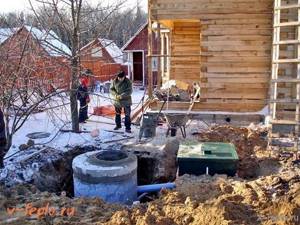
Regardless of what materials were used in the construction of the sewage facility, insulation of the well for the winter is mandatory. To reliably protect the structure from exposure to low temperatures, you need to perform a set of procedures that are described below.
Step one. Start by protecting the top of your septic tank. First of all, insulate the well cover, and then proceed to thermal insulation of the sewer pipes through which waste is supplied to the structure from the house.
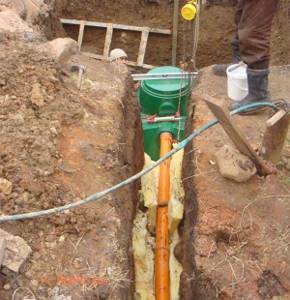
Step two. Then proceed to install the thermal insulator around the well itself. This procedure, frankly, is no different from the methods of insulating a conventional well described above. Therefore, we will not dwell on it.
Does the well freeze in winter?
An interesting question: somehow our ancestors managed without thermal insulation. And the next question is, is it necessary to insulate the well?
Yes, the well freezes, and there are several reasons for this:
- the location of the aquifer above the depth of soil freezing. In this case, the water in the well will freeze, because... it transmits the temperature of the soil. If the water level is lower, then there is no need for insulation;
- lack of insulation;
- Irrational pipe laying. A plumbing system is a system of pipes through which water is supplied to the house. Depending on the depth of their placement depends on their ability to resist freezing. They also need to insulate the place where pipes are inserted into a mine or where they enter a house;
- opening head. The difference between the water in the well and the air temperature can exceed 30 °C. Wooden houses installed on traditional wells prevented direct contact between warm water and cold air. If there is no house, then the water becomes covered with an ice crust. And the greater the temperature difference, the thicker the crust formed;
- use of material with high thermal conductivity for the construction of a well: brick, concrete rings, monolithic concrete structure.
The last point answers the question why our ancestors’ wells did not freeze - because they were made of wood, and this is the best natural thermal insulation of a well.
Insulation of a country well from concrete rings
Insulating the topmost ring of a well is actually not that difficult. The technique of this procedure is quite clear and primitive. To explain briefly and concisely, the top concrete ring needs to be covered with the familiar polystyrene foam.
Let us consider in detail the progress of the work to be performed
- The wall ring needs to be dug out twenty centimeters - to the depth of ground freezing. In total you will have to go deeper by about 1.2 meters. Since this is not very comfortable to do, you will have to dig a fairly large pit. If you count the rings from above, then it is enough to get by with a depth of 20 cm below the junction of the first two rings.
- We take layers of foamed polymer and cut it into strips 20 cm wide. High-density material is more suitable, and the best option would be to purchase extruded or ordinary foam.
- We clean the wall rings from dust and dirt, moisten them with water, and glue the parts of the prepared foam polymer with special glue.
- When the surface of the ring is fully covered, the gaps between the individual strips of foamed polymer are filled with foam for installation. Its remains are cut off after complete drying, the soil around the well is added, and the well itself is put in order.
So that the foam for installation work does not fade in the sun and the foamed polymer does not deteriorate, the structure is reinforced with a mesh and then covered with a layer of plaster. This option is very effective, but it doesn’t really help in all cases: the cold can penetrate through the top.
Thanks to this, it will be better, without delay, to move on to the next insulation method with your own hands.
What is a warm shutter?

It must be stated that this is a specialized cork with small holes made in it. One of them serves for ventilation and prevents water spoilage. The second is for the intake hose. This option will be optimal for a summer cottage, which is supplied with well water using a pump.
How to make such a shutter lid?
- It is necessary to make two similar rings from moisture-resistant plywood, corresponding in size to the inner diameter of the concrete ring of the well.
- One of the rings is covered with 5-centimeter polystyrene foam. All remnants are carefully cut off: the foam circle should exactly repeat the shape of the plywood one.
- The second plywood circle is glued on top of the foamed polymer.
- Final stage. We drill two 6-centimeter holes (for ventilation and for the hose), make a handle to which we attach a thick rope or chain, so that in the spring you can easily remove this plug.
There is nothing difficult in all these events, but there is also no special beauty here.
It should be noted that the considered methods of thermal insulation with polystyrene foam are suitable only if the water supply is carried out using a pump.
If water is taken from the well with a bucket and a collar, then it is unlikely that the stopper will help. In this case, there is another, third method of insulating a well with your own hands.
Insulation of water wells
This is an excellent option for every occasion. There is an optimal way to thermally insulate a well, which solves several problems at the same time: the appearance of the site outside the city will not be affected at all, and the insulation will be done really well. This primitive and good method is the construction of a special closed well house.
Closed well house
This design solves the following problems:
- Prevents water from clogging with leaves and other small debris. A thoughtful and airtight house with a tight lid will not allow anything unnecessary to get into the source.
- The well will not freeze in winter. In the only case such a house will not save you from freezing if the water level in the well is higher than the ground freezing level. If this is the case, then it will be necessary to implement additional insulation of the upper wall ring with polystyrene foam.
If insulating a well yourself seems too difficult to you, you can make the task easier for yourself. At a minimum, you won't have to do most of the work yourself. Foam half-rings, a warm seal and good sealed houses themselves can be purchased at hardware stores.
All you need to do is install such products, and this, of course, is several times easier. Well, factory-made products, in most cases, will look much more beautiful than homemade ones. This is especially true for a well house. Still, only homemade interior items will give the site an original and distinctive look.
When insulation is necessary
Any well must be insulated not only to prevent water from freezing. Sometimes insulation is required to protect the structure from snow, small debris (leaves and branches) and temperature changes.
It should be remembered that thermal insulation is needed when the surface of the water surface is above the freezing level of the soil. Otherwise, insulation may not be necessary - the water will not freeze and this will not lead to damage to the pumping equipment.
Why is it necessary to insulate?
The main reason for insulating a well is the need to ensure uninterrupted water supply in winter.
In addition, freezing of water in a well and the formation of an ice lens in it can damage the walls and dislodge the rings. This movement can damage the pipes leading into the house.
Equipment installed in the well may also be damaged:
- pump;
- intake pipe;
- filter.
It no longer makes much sense to insulate the well walls and head in the winter, after it has frozen. It is necessary to take care of insulation in advance. It is best to do this when building a well.
On a note
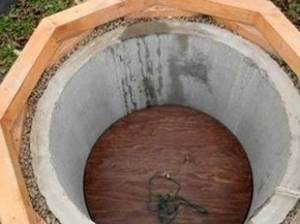
To do this, disinfection is carried out, and then water is pumped out of the mine. An insulated lid is lowered onto the top ring. On top it is covered with plastic film and generously filled with any insulation of natural origin - fallen leaves, straw, sawdust. It is believed that the water in the well will arrive only in the spring. Although in fact this can happen much earlier if a well shaft is placed on a powerful water vein. Wells that have wooden walls instead of concrete rings are not insulated with anything additional, except for the lid.
Expanded polystyrene is rightfully considered the best insulation for rings. It is resistant to moisture and fungus, does not deform and can be easily dismantled if necessary. The only disadvantage of the material is the fear of ultraviolet radiation.
Durable materials are used to insulate the cover. Mineral wool and other brittle material can contaminate the water.
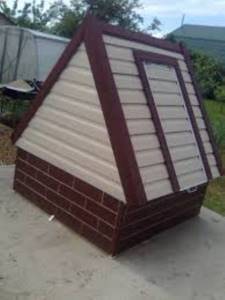
A vent in the lid will help prevent the appearance of a musty odor that spoils the taste of the water. The length of the ventilation pipe should be no more than two meters and a diameter of six centimeters. Its lower end cannot touch the water. Be sure to take this into account if the work is carried out by a third-party contractor. Deceiving clients during well construction is a common occurrence.
A reinforced concrete cover in the form of a nut, equipped with a plastic hatch, is considered more reliable and durable. It can be installed not only during construction, but also at any convenient time. To do this, the upper ring is dismantled. The washer is installed between it and the first circle located below ground level. Then the removed ring returns to its place. All joints are hermetically sealed with cement mortar. If desired, you can pour insulation onto the manhole cover and in this condition preserve the well for the winter. This method of insulation cannot be considered budget-friendly. The price of the washer is from 19,000 rubles.
Insulation of well walls
To insulate the walls of a well, you can use almost any material offered by modern manufacturers. In any case, it is necessary to build a trench around the well. Its depth should correspond to the freezing depth of the ground. For the middle zone it fluctuates within two meters. For insulation, experts recommend using the following types of insulation:
- Half rings made of polystyrene. The distinctive characteristics of the material are minimal heat transfer and excellent moisture resistance, which allows for reliable protection even at very low temperatures. It's quite easy to work with. Fixation is carried out using frost-resistant glue and dowels. The structure is insulated from above with roofing felt and roofing felt.
- Izolon is self-adhesive. The material is characterized by ease of use. For insulation, it is enough to wrap the well around it. It is also advisable to install insulation using roofing felt and roofing felt.
- Polyurethane foam. A three-centimeter layer of foam is mounted to the walls of the well. The material fills all the cracks, providing excellent thermal and waterproofing. The disadvantages of this material include the sensitivity of polyurethane foam to ultraviolet radiation, but this can be easily corrected by hiding the material under decorative cladding.
Once the insulation of the well is completed, the trench is filled in from the outside. As a result of the work carried out, the temperature inside the well is above zero even in the harshest winter.
It is important to protect the surface of the well from water, which is important when using a bucket for collection. Water on the surface freezes, ice forms, which in turn can lead to problems with the use of the well
Why is insulation necessary?
By insulating the well, it will be possible to maintain a satisfactory temperature inside it, allowing water to remain in liquid form even in high frosts, without forming ice on the surface.

The appearance of an ice layer not only makes it difficult to collect fluid, but can also lead to cracks in concrete circles, or damage wires or pipes located in the well.
The circles begin to break down and age ahead of schedule. As a result, their service life is significantly reduced. If pipes freeze or cables are damaged, repairs will be necessary, which will not be cheap and will require labor-intensive processes.
Method three. Construction of a wooden house
If your site is located in an area where the temperature in winter is not too low, you can build a protective wooden frame over the shaft. To do this, prepare:
- wire;
- nails;
- waterproof film;
- logs;
- plywood sheets;
- expanded polystyrene.
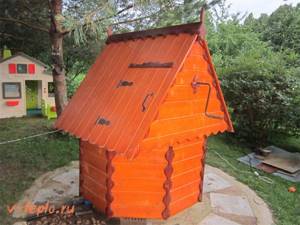
Step one. First of all, cover the inside of the top ring with a pre-prepared film. Next, take the foam and cut out six rectangles from it. Make the dimensions of the latter such that as a result of lining the ring, an even hexagon is formed. This little trick will significantly increase the adhesion density of the foam.
Step two. Then you need to secure the foam. To do this, wrap it with ordinary wire in at least three rings. It is advisable to use aluminum wire for this, since it does not rust and is quite soft. As a result, it will be easy to manipulate, and there will be no corrosion on the surface of the insulating layer.
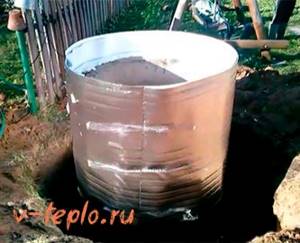
Step three. After this, build a log house from small-sized logs. The height of the log house must be level with the well itself, and its shape must be hexagonal. Place a cover consisting of several layers on top of the finished house (as described in the first insulation method). Then you can paint the structure so that it is not only functional, but also aesthetic.
Video - House installation
For a more detailed introduction to the technology, we recommend watching the thematic video material.
https://youtube.com/watch?v=zFxBdPaUM
Measures against freezing
When installing a well on a site, craftsmen advise to think in advance about the possibility of it freezing in the winter. Already during the work of digging out a source of drinking water and its construction, a number of works are carried out to protect the concrete structure
Even if it is used for a short period of time, a number of protective measures must be taken.
This will help maintain the purity, quantity and quality of water, and the serviceability of instruments and water collection devices for longer. Necessary actions:
- treating the walls of the log house with disinfectants;
- pumping out water and drying the log house;
- laying water pipes at the required level: below the soil freezing level;
- additional arrangement of pipes and fastenings of pumping equipment;
- protection of concrete from the effects of natural phenomena that destroy its quality.
What to do to prevent the well from freezing?
To prevent the well from freezing in winter, this must be taken care of during construction. If people live in the house only in the summer, there are no special problems. After use, the well is cleaned and treated with chloramine or another disinfectant.
Then you should completely pump out the water and close the structure with a lid. The top of the structure can be covered with polyethylene and covered with leaves. By spring, the well will be filled with clean, fresh water.
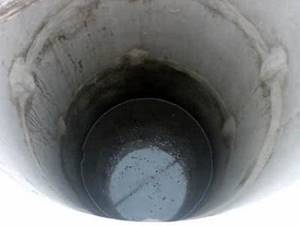
The water in a concrete well freezes at the same level as the surrounding soil
The structure used in winter requires additional arrangement. Naturally, all water pipes are laid below the freezing level. If a surface pump is used, it is either installed in a heated room or in a coffered pit near the well.
The well itself is best equipped with a wooden house. For insulation, it will be enough to fill the voids between the wooden frame and the well ring with thermal insulation material (expanded clay, polystyrene, etc.).
Preventing the well from freezing
To prevent the well structure from freezing with the onset of winter, thermal insulation should be taken care of during its construction. If the suburban area will be visited occasionally (for example, only on weekends), then, in principle, there is no need to insulate the well. In such cases, it is only necessary to clean it and treat it with some kind of disinfectant (such as chloramine) before leaving.
After this, pump out the water completely and close the structure with a lid. Lay a polyethylene film over the lid and cover it all with leaves. Now you can go to the city with a clear conscience, because with the onset of warmth, the well will again provide clean water.

But if the well is used regularly, then the measures should be more serious. For example, pipes to the house must be located below the soil freezing line, the structure itself must be protected by the house described above, or by other available means.
Which wells need insulation?
Buildings built according to the old tradition from wood do not need insulation. Such designs retain heat well. The only thing you may need is an insulating cover for the well. It is made of wood and installed inside the well. The cover protects the structure not only from temperature changes, but also from the ingress of snow and other objects.

Insulating cover installed in a concrete well
In modern construction, concrete structures are used to equip wells. They are more durable, cheaper and their installation takes less time and effort. At the same time, owners of such wells are faced with the need to protect the structure from low temperatures. Concrete has good thermal conductivity, so products made from this material freeze to the same depth as the surrounding soil.
In what cases is insulation required?
If the well was built according to ancient traditions (read: made of wood), then, of course, it does not need any thermal insulation. There are exceptions - for example, a well cover needs insulation. In this case, it is necessary to make an additional cover from wood and fix it inside the structure itself. This cover will protect the country well from:
- snowfall;
- temperature changes;
- ingress of dry leaves and other debris.
Note that almost all modern wells are constructed using reinforced concrete rings. Such wells have numerous advantages, including:
- strength;
- reliability;
- durability;
- ease of installation and further maintenance.
Despite this, they have one significant drawback: they need to be insulated for the winter.
On a note! If the water in the structure is located below the soil freezing level, then the structure itself will not freeze. But if it’s higher, then installation of insulating material is required!
There are three thermal insulation technologies:
- insulation of the structure cover;
- thermal insulation of the upper ring;
- construction of a decorative house.
Let's take a closer look at each of the possible methods.
Principles of insulation
The basic principle of insulation is the creation of a heat-insulating barrier between frozen soil, cold air and a layer of water. Insulation methods vary depending on the wall material, the method of its use and the level of the aquifer relative to the freezing depth.
Wooden wells
The logs of a traditional log house themselves have sufficient thermal insulation and do not allow cold to pass through to the water. In this case, you will only have to take care of insulating the head. The traditional design - a house with a door - was made of thick boards that fit well together and served as a sufficient barrier to cold air. If the head is made of plywood or OSB, it will have to be additionally insulated with polystyrene foam or penofol.
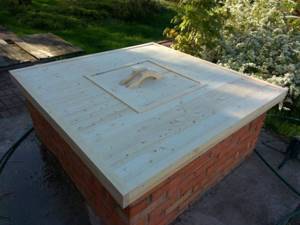
Wooden insulation
Concrete wells
Concrete has high thermal conductivity and quickly transmits cold from frozen soil. The best way is to insulate the outer surface of the walls during construction. If the well has already been built, there are methods of internal insulation. They are less effective, especially if the water level significantly exceeds the freezing depth, but they can also help out the owner. Of course, it will be necessary to insulate the head as well.
What to do if the water in the well is frozen?
Wrap the base of the structure with polystyrene foam
If the winter turned out to be really very cold, but you did not have time to insulate your source, you will have to familiarize yourself with the features of its “defrosting”. What will it take?
- Assess the degree of freezing of water at the source;
- If the layer of ice is not too thick, break it with a crowbar;
- After this, remove large pieces of ice from the water;
- Cover the source with an insulated lid;
- Wrap the base of the structure with polystyrene foam.
In essence, thermal insulation of a well is a way to extend the “life” of the entire structure. When water freezes, the walls of the source begin to quickly collapse, making it no longer possible to operate it. To insulate a structure, you can use materials such as penoplex, expanded polystyrene, izolon and others. They will protect the well from water freezing, and the structure itself from deformation and complete destruction.
How to choose insulation for a well made of concrete rings
To produce high-quality thermal insulation of a well, it is necessary to choose insulation that is not subject to water absorption. It is best to give preference to the following thermal insulators:
- Styrofoam. This building material is very popular among consumers. It has a low level of thermal conductivity, adequate cost, ease of use, and sufficient resistance to deformation during soil movement. In addition, with foam plastic sheets there are no installation difficulties; they are easy to process and cut. You can also buy semicircular material on the market. It is easy to fix such elements onto concrete rings using umbrella dowels. A waterproofing layer is laid on top. Upon completion of the work, the pit around the well is protected with soil. The only disadvantage of polystyrene foam is that it can be damaged by rodents, which take refuge in it for the winter.
- Extruded polystyrene foam. This material is very similar to polystyrene foam, but has better performance: lower thermal conductivity, increased resistance to heavy loads. It can be used effectively for thermal insulation of wells made of concrete rings, but foam plastic wins in terms of price. The material is sold in the form of slabs. The optimal width for insulating a hydraulic structure is 30 cm. They can be laid on the surface of a concrete structure. As for the technology, it is the same as using foam plastic. Upon completion, the connecting points must be blown out using polyurethane foam.
- Polymer insulation with a cellular structure. Rolled heat insulation is characterized by a low level of thermal conductivity, sufficient flexibility, resistance to a humid environment, and heavy loads. It is quite suitable for insulating a well from freezing. Its popular representatives are isolon, isonel, penolin. There is also a self-adhesive product. In the absence of a sticky layer, it is good to use an adhesive composition for external work on a concrete surface. The connecting points should be taped to prevent moisture from penetrating inside. The final stage will be filling the trench with soil.
- Polyurethane foam. The material is applied by spraying onto the surface to be treated. When the mixture hardens, a durable coating will appear that does not require additional waterproofing. Among the advantages of insulation are: low thermal conductivity, plasticity, and the ability to withstand heavy loads. The material is not damaged by rodents and insects. The only downside is the high cost and the involvement of specialists.
Important! It is not practical to use mineral wool for thermal insulation of wells made of concrete rings. Without a proper waterproofing layer, it will quickly absorb moisture from the soil, freeze, and cause a violation of the integrity of the hydraulic structure.
Arrangement and protection of water supply from a well for the winter ↑
The water supply from the well will not freeze if the basic rules for installing pipes are followed: laying and insertion are made at a sufficient depth and carefully insulated. The diagram shows the correct location of pipes in the ground, correct insertion through the ring wall and the depth of shaft insulation.

The entrance of the outlet pipe to the well wall should be below the freezing point of the soil in the most severe frost. It is advisable to install a special coupling: a short plastic pipe. The entry point is sealed.
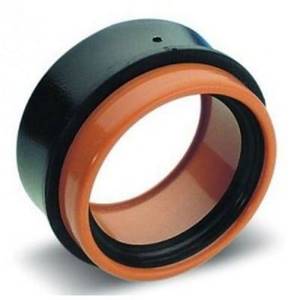
A rigid plastic shell will fix the pipe, protect it from deformation and friction against the wall, and most importantly, it will make it possible to thermally insulate the pipe. This is what the sandwich design of the pipeline insertion into the ring looks like.

At the entrance to the house, careful thermal insulation is required: often it is not possible to make a deep connection; the pipeline has to be raised to the surface.
In a special coupling made of flexible polyethylene, a pipe with insulation
Water will not freeze in a pipe from a well if reliable protection is provided along the entire length of the underground section. For thermal insulation, ready-made polystyrene foam cuffs and mineral wool are used. Ready-made factory insulating materials are sold in the form of a shell of two parts with a “groove” connection.
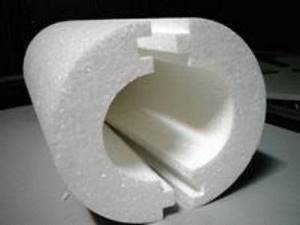
Instead of polystyrene foam cuffs, you can use any rolled material - sheets of polyurethane foam, PVC. Narrow tapes are wound diagonally around the pipe and periodically secured with clamps.
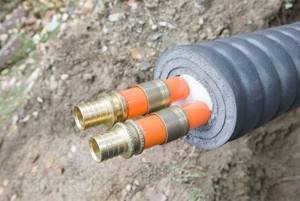
In addition to the cuffs, an external protective shell is required - a flexible or rigid hollow pipe. If the pipeline is laid above the freezing point, or it is not possible to deepen the trench, an electric heating cable is used.
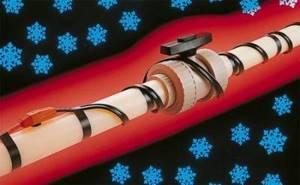
The wire is connected to the pipe with plastic clamps, adhesive tape or a special fixing sticky material. The cable with the switch is taken out indoors and connected to the network.
Useful video instructions about the technology of heating an underground pipe in winter.
There is nothing difficult about protecting the outside of the well from freezing on your own. And it is better to entrust the equipment of automated water supply from a home well to specialists. Errors in calculations and insufficient pipeline laying depth can lead to pipe ruptures in winter. It will not be possible to repair the system in cold weather; you will have to look for an alternative source of water for the winter. And the cost of repairs is almost equal to installing a new system.
Insulation principles and materials
The question of how to insulate a well is solved in different ways. They are based on the following principles: deepening below the soil freezing level, thermal insulation of the entire well shaft or only its upper part.
Previously, wells were built in the form of a log house, insulation was provided by the high thermal insulation properties of wood. Today the following insulation materials are used:
- expanded polystyrene;
- penoizol;
- penoplex;
- polyurethane foam.
How to insulate a brick well
You can insulate an existing brick well using the same methods that are used for concrete wall rings. It's a completely different matter if construction is just starting.
Then waterproofing and insulation of the brickwork is carried out during the work process:
- The well trunk does not have to be round; it can also have a square or rectangular shape. In this case, well masonry with insulation is the most suitable option. This is a very popular method of building walls in the construction of houses: bricks are laid so that empty wells are formed in their thickness, which are covered with sawdust, expanded clay, polystyrene chips, or filled with foam insulation.
Insulation of a brick wall
- In another option, two parallel walls are erected, rigidly connected to each other by anchors, the space between which is also filled. Well masonry with insulation is very convenient for arranging a reservoir in a finished pit. This can be a drinking water intake up to six meters deep, or any other type of well: differential, rotary, inspection.
- Of course, a well does not require the same thickness of walls as a building - one and a half bricks are enough. After completing the masonry work, all that remains is to plaster the outside of the wall and make a drainage sleeve. If you add a plasticizer to the mortar for masonry and plaster, the strength and waterproofing of the walls being built will be ensured to the maximum.
For a drinking well, it is advisable to make a house or a canopy so that it does not get covered with snow in winter. As for the lid: it is better if it is multi-layered wood.

